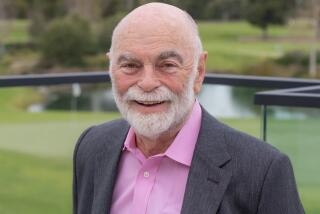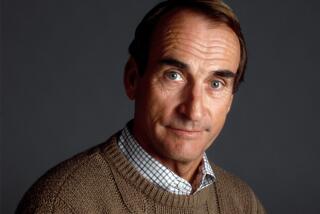Appreciation: Patrick Macnee: The essence of a gentleman
The actor Patrick Macnee died Thursday at 93, after a long career that resolves itself into a single, yet long-running and highly memorable, pop-culturally resonant role. Indeed, among the fictional secret agents of the 1960s and ‘70s, there are above all James Bond, whose water has been carried by many actors, with many more undoubtedly to come, and John Steed, who was only ever and ever will be Patrick Macnee.
(It’s true that Ralph Fiennes played him in a movie. The statement holds.)
Before and after “The Avengers” made him a star around the time he turned 40, Macnee was a presence, if not a constant presence, on screen, appearances that as a fan I would note with a certain affectionate satisfaction. It still comes as something of a surprise to see him as the young Jacob Marley in the 1951 Alistair Sim “A Christmas Carol,” even though it’s a film I watch every year, and in “This Is Spinal Tap” (as record executive Sir Denis Eton-Hogg).
He played Dr. Watson opposite Roger Moore in the 1976 “Sherlock Holmes in New York” (with whom he also teamed in the 1985 Bond film “A View to a Kill”) and opposite Christopher Lee in a pair of 1992 Holmes-themed TV movies. He played Holmes himself a year later in the Canadian “The Hound of London.” It would be flattering to call some of his later vehicles undistinguished, though more famous actors did worse work in their late careers.
And he left us Steed.
Wit and cool
At some point in the life of the popular culture, it became the thing to psychologize our heroes; to film them up with motivation, to analyze the internal costs of their actions — to every triumph its trauma. There is none of that with Steed. Although by combing carefully through the series, one can gather a few facts about his upbringing, they are all basically beside the point.
Steed is an essence, a collection of attitudes, a way of dressing, of walking, an “air of casual elegance,” to borrow Steed’s own, lightly mocking description of himself. The details of his employment are sketchy at best; other than to get to the bottom of whatever thing needs its bottom got to, his mission is vague.
He was a gent, but he wasn’t posh; the character was able to mix with aristocrats and with tradesmen, to pass as whatever the moment required with no adjustment of his being or change in his dress, which, when he was out of his flat, consisted exclusively of three-piece tailored suits (Pierre Cardin got a screen credit) and a bowler hat. An umbrella with a sword in its handle was his trademark accessory.
Steed’s hallmarks were wit and cool. He might betray at times a kind of stern concern, but he did not anger, and he didn’t panic. Possibly, if you watched “The Avengers” from beginning to end, you might find a trickle of perspiration, the odd bead of sweat. But saving the world — which is to say England — was always fundamentally a lark, however many bodies piled up around him.
Part of Macnee’s brilliance in the role was the easy, complementary and apparently egoless way he worked with a succession of female costars — never sidekicks, always partners — from Honor Blackman to Diana Rigg to Linda Thorson in the original series, which ran from 1961 to 1969, and finally to Joanna Lumley in “The New Avengers,” a mid-’70s revival that saw Steed kicked upstairs and Gareth Hunt brought in to do the heavy lifting and leg work.
That Macnee was older, and Steed the thread that held the series together from first to last, could make him seem at first glance the senior — because, literally, he was. But “The Avengers” was the most sexually equitable of series, and something of a rebuke to the objectifying misogyny of the Bond series and the series it inspired. With some exceptions (including “Avengers” vet Blackman’s part in “Goldfinger”), “Bond girls” were liberated only in the sense that they were available for sex. “The Avengers” could be “sexy,” but it was not sexist.
Strong individuals
And though there was a certain unavoidable flirtation between the partners, there was never the sort of sexual tension that now powers most every film or TV show in which a man and a woman investigate mysteries together. Questions of “Will they or they won’t they?” or “Do they or don’t they?,” though they may have been entertained by some viewers, were never seriously addressed by the series itself.
One episode, in which a coupled pair of villains swaps brains with Steed and Emma, lets viewers see Macnee and Rigg in romantic poses, but that’s as close as it ever got. If anything, the series stands as a paean to the way strong individuals can team up without sacrificing an iota of their individuality.
What do we say of the actor so identified with a particular character that we don’t know where one begins and the other ends? Of the star whose other work we need to work to call to mind?
We might hazard that their career was all their craft could handle; but though Steed was not called upon to express a wide range of emotions, those limitations were written into the role. Macnee had been a working actor for many years; he was flexible. We might say he was typecast afterward, and there is some truth in that.
Above all, we should say, as is true of all actors everywhere, that he was fortunate — fortunate to find the part that resonated with him, and within him, in an almost acoustical sense. The role that made him bigger, and that he made bigger and indelible. Perfection is always a matter of the stars aligning, and they were lucky for us as well, when Macnee met Steed.
Robert Lloyd is on Twitter @LATimesTVLloyd
More to Read
The complete guide to home viewing
Get Screen Gab for everything about the TV shows and streaming movies everyone’s talking about.
You may occasionally receive promotional content from the Los Angeles Times.







